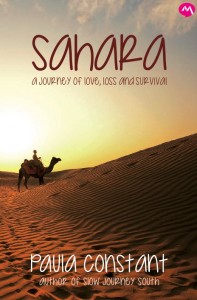Sahara by Paula Constant is a sequel to her first book Slow Journey South. In the first book, she wrote about her walk from London to Morocco. In Sahara, she tells the story of walking through the Sahara desert along with her camels. She walks through the countries of Morocco, Mauritania, Mali and finally Niger. Niger, where she had to terminate her journey for more than one reasons. I was inspired by her first leg of the journey itself, in this leg, I developed a sheer admiration for her. Admiration for dealing with a personal crisis. Walking through a painful physical condition, for learning at every step, for making mistakes but refusing to fail. And finally for not letting her courage go down in the most demanding circumstances.
For most of us, Sahara is one seamless desert that lies somewhere in North Africa. We never realize that it passes through many countries. And many communities and tribes inhabit it – Arabian to African and their combinations in various proportions. There are nomadic tribes and there are settlements in cities in the desert. Reading this book gave me a bit of insight into the landscape that I knew nothing about. It introduced me to the tribal culture on this land, educating me on their lifestyles and values. It is interesting to see that every community and country not only has its own food, language, and style of dressing but their social norms are also very peculiar to them.
As a protagonist, Paula Constant takes you through the landscape. Through her personal challenges, which are so many that you really empathize with her. You admire her for learning on the way on how to deal with different tribes. Her choice of guides – sometimes excellent and sometimes pathetic, makes for one hell of a narrative. When you hear the travel story you know how important a guide can be for such an expedition.
When you hear her stories of dealing with being a white woman traveling all by herself, you realize the amount of bias a single woman can face in remote places. What I loved about Paula Constant is her ability to understand the situation and deal with it on the go without ever shifting her focus from the mission. She walks like a possessed woman dealing with all oddities – personal, regional or illness. You feel sorry when her expedition is aborted midway in Niger for issues beyond her control. But you somewhere know that she would be back as soon as she can.
I read both the books back to back and found a few inconsistencies. The name of her aid in Morocco in the first book was M’barak while she refers to him as Kadar in the second book. Given the relevance of character to her story, I do not see the room for confusion or editing issue. As a reader, it gave me a disconnect in the flow. Secondly, in the first book, she never mentions anything wrong between her and her husband, while the second book begins with a discord and a built up for the upcoming split.
If you read one book you would not notice this but if you read both the books it stands out. Another inconsistency is the fact that at the end of the first journey they had no money left with them, then how did they manage the money for the second leg? Which they began as per their schedule. In this book, I also wanted the deeper insights into her mind, which came in the first leg, but in this leg, she tends to keep to the operational narrative. I am sure she had undergone a lot mentally and emotionally but for some reasons, she chooses to not explore that or not share that with the readers.
An excellent read, especially if you ever plan to do an expedition – big or small.
You may buy this book – Sahara A Journey of Love, Loss and Survival by Paula Constant at Amazon.









